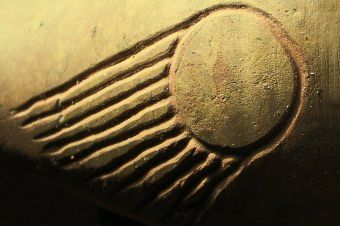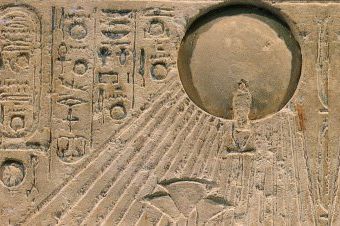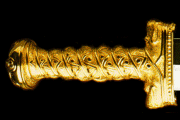Page 4 of 5
The End of Eden
The Great Comet
The ancient Chinese regarded comets as gods or other supernatural beings that appeared in the sky as astrological omens. Consequently, they meticulously recorded their appearances. One such record survives as a text printed on silk, known as the Mawangdui Silk Almanac, discovered in an ancient tomb uncovered at Changsha in south-central China in the 1970s. Although this almanac dated from around 300 BC, it included copies of astronomical observations going back well over a thousand years earlier, and one of the first it records is a massive comet that appeared in 1486 BC.
Now preserved in the Hunan Provincial Museum in Changsha, China, the ancient Mawangdui Silk Almanac records the appearance of comets going back three and a half thousand years.
Contrary to what might be expected, a comet’s tail is not like the vapor trail of a jet streaming out behind it, but points only away from the sun, regardless of which direction the comet is traveling. This tail can be millions of miles long and dependent on circumstances can appear straight or curved. A cometary tail always point away from the sun, but depending on its relative position to us, and our relative position to the sun, as observed from earth it can stream in any direction relative to the horizon: up, down, left or right, or anything in between.
The seven-tailed De Cheseaux’s Comet of 1744 was the largest recorded since the birth of modern astronomy. The ten-tailed comet of 1486 BC, however, was far more impressive. Woodcut from Amedee Guillemin’s
Heaven’s Gate showing the tails of the 1744 comet displayed above the horizon.
When Halley’s Comet appeared in 1910 it had five tails and was the most spectacular to appear since the
invention of photography.
Cometary orbits around the sun can vary from less than a hundred to many thousands of years, and depending on such factors as how large they are and how close a particular orbit brings it to earth, comets can vary in appearance each time around. Halley’s Comet, for example, whose orbit is 76 years, was magnificent when it came within 13 million miles of earth in 1910, but its reappearance in 1986 was far less dramatic as it only came within 38 million miles.
The Chinese Lao-Tien-Yeh glyph (above left) and the Egyptian Aten symbol (above right). Were these images representing the new gods first recorded in the year1486 BC both inspired by a comet?




Astronomers have likened comets to dirty snowballs as they are composed of particles of matter and various gases held together in water ice and frozen carbon dioxide. They average between half a mile and fifteen miles in diameter, although some can be as large as 200 miles across. These frozen objects left over from the formation of the solar system orbit the sun in elliptical orbits which take them repeatedly much closer to the sun and then far back out into space. For most of the time they are invisible to the naked eye but when they swing in closer to the sun and warm up, the surface ice vaporizes and dust and gasses are discharged into space which glow with the sun’s reflected light. This shining aura of dust and gases, called the coma, is typically a few hundred thousand miles in diameter and can therefore often be seen from earth. As the comet continues in towards the sun, some of the coma is stripped away by the solar wind – a stream of high-energy sub-atomic particles emanating from the sun – to form the familiar comet’s tail, or in some cases a number of tails.
In 1985 the renowned astronomer Carl Sagan drew attention to the comet observed by the ancient Chinese in 1486 BC, proposing that it had to have been one of the most spectacular seen in recorded history. The two most magnificent comets since the birth of modern astronomy were Halley’s Comet when it appeared in 1910 which had five tails, and the seven-tailed De Cheseaux’s Comet of 1744. The comet the Chinese recorded in 1486 BC was far bigger: it appeared as a massive sphere of light, had ten tails, and lit up half the sky. What no one seems to have appreciated before is that this comet, which would have been visible throughout much on the northern hemisphere, may well have inspired civilizations across the world to adopt their new gods.

It is not only that the Chinese gave this comet the same name as the new deity that is first recorded at the time - The Great God - but that the glyph representing the god could well depict a multi-tailed comet. Moreover, the various celestial disks in other parts of the world representing the new gods that are suddenly recorded at this exact same time could well have been depictions of the same comet. They could all have been stylized portrayals of a large circular coma with a splendid array of tails spreading out beneath it in the shape of a fan.








